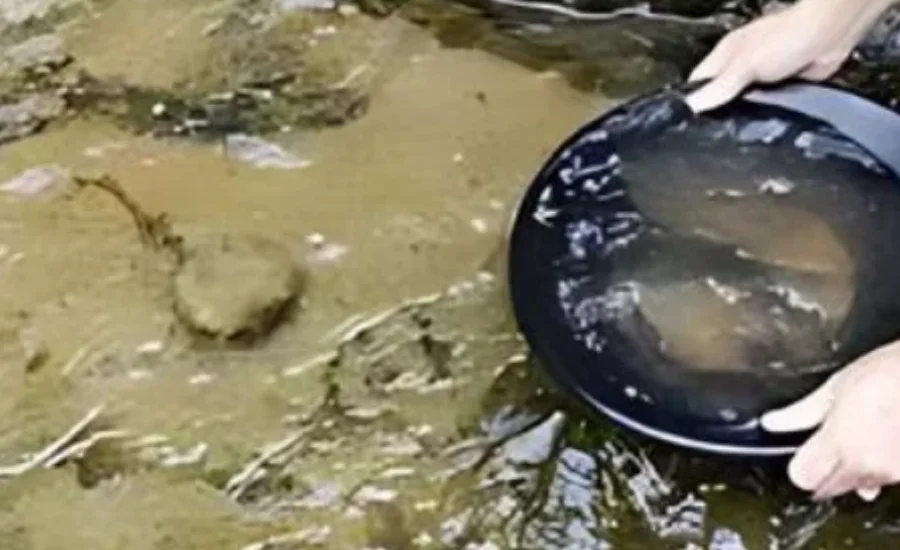Tertib ketika mendulang emas: Gold panning has long captivated individuals driven by the allure of discovering riches. While the process of gold panning might appear straightforward, it’s essential to adhere to best practices to ensure both safety and success. Ignoring these guidelines can turn a potentially rewarding activity into one fraught with challenges and disappointments. This article aims to highlight why following these established methods is crucial, whether you’re a seasoned miner or just someone fascinated by the idea of striking gold. Understanding and implementing these practices can make a significant difference in your gold panning experience, reducing risks and enhancing your chances of success.
The Importance of Best Practices in Gold Panning
- Ensuring Personal Safety: When it comes to gold panning, the safety of all involved is paramount. Following established best practices is essential to minimizing the risk of accidents and injuries. This includes selecting the right tools, such as sturdy pans and shovels, as well as wearing protective gear like gloves and boots. Additionally, it’s crucial to consider factors such as the terrain, water currents, and weather conditions, which can all significantly impact safety. By being mindful of these elements, you can greatly reduce the likelihood of dangerous situations arising.
- Protecting the Environment: Gold panning, if not conducted responsibly, can have devastating environmental consequences. Best practices in this activity emphasize minimizing the impact on the surrounding ecosystem. This means avoiding the use of harmful chemicals like mercury, which can contaminate water sources, and taking steps to prevent soil erosion and habitat destruction. By adhering to these guidelines, miners can help preserve the environment for future generations while still pursuing their passion for gold panning.
- Compliance with Legal Regulations: Adhering to legal requirements is another crucial aspect of responsible gold panning. Each country or region has specific laws governing the practice, and failure to comply can result in fines, legal action, or even the closure of mining sites. Best practices dictate that miners must obtain the necessary licenses, respect property boundaries, and adhere to environmental regulations. Staying within the bounds of the law not only protects miners from legal repercussions but also ensures that the industry operates under proper standards.
- Sustainable Resource Management: Gold is a finite resource, and its extraction must be managed carefully to ensure it remains available for future generations. Best practices in gold panning advocate for the use of methods that reduce waste and maximize efficiency. This includes optimizing water usage, managing mining waste responsibly, and restoring land after it has been mined. By focusing on sustainability, miners can ensure that gold panning remains a viable activity without causing long-term harm to the environment.
- Maximizing Efficiency and Yield: Finally, following best practices in gold panning can significantly enhance both the efficiency and yield of the process. By employing the right techniques and equipment, miners can increase their chances of success. For instance, learning the proper way to swirl the pan to separate gold from other materials can lead to better results. Additionally, understanding where to search for gold, such as in riverbeds that are likely to contain the precious metal, can make the process more productive. By refining these aspects of the activity, miners can improve their outcomes and make the most of their efforts.
The History of Gold Mining in Indonesia

Indonesia’s gold mining history is both rich and complex, with roots stretching back centuries. Ancient civilizations, such as the Majapahit Empire, recognized the value of gold and engaged in its extraction as early as the 13th century. These early efforts laid the foundation for a long-standing tradition of gold mining in the region.
The colonial era marked a significant shift in gold mining activities. Foreign powers, particularly the Dutch, intensified the exploitation of Indonesia’s mineral wealth. They established large-scale mining operations that drastically altered local communities and economies, leaving a lasting impact on the country’s development.
Following Indonesia’s independence in 1945, gold mining saw a resurgence at the grassroots level. Small-scale miners began independently extracting gold from rivers and hillsides, a practice that continues to support local livelihoods and contribute to national revenue. This informal sector plays a vital role in the country’s economy, despite the challenges it faces.
The discovery of new gold deposits in areas like Sumbawa and East Kalimantan attracted multinational corporations eager to invest in Indonesia’s mining sector. These modern operations have introduced advanced techniques that increase efficiency but also bring environmental concerns. Balancing these industrial advancements with traditional practices remains a critical challenge for the industry.
Today, Indonesia is recognized as one of the world’s leading gold producers. The evolution of gold mining in the country reflects a blend of ancient traditions and modern innovations, highlighting Indonesia’s ongoing journey in this thriving sector.
Methods Used in Gold Mining
Gold mining in Indonesia employs a variety of methods, each with its own set of techniques and tools, tailored to different scales of operation.
One of the oldest and most traditional methods is panning, where miners sift through river sediments to separate gold from other materials. This hands-on approach remains popular among small-scale miners for its simplicity and effectiveness.
Sluicing is another widely used technique, particularly among artisanal miners. It involves directing water through a sloped channel lined with riffles, which trap the heavier gold particles as the water flows over them. This method is efficient for processing large volumes of sediment.
For larger, industrial-scale operations, open-pit mining has become the method of choice. This technique involves using heavy machinery to dig deep into the earth, exposing layers of gold-bearing ore. While highly productive, open-pit mining can have significant environmental impacts, such as landscape alteration and habitat destruction.
Underground mining offers an alternative for accessing deeper gold deposits. This method involves constructing tunnels and shafts to reach gold deposits located far beneath the surface. It is a more targeted approach, often used in areas where open-pit mining is not feasible.
In recent years, technological advancements have led to the adoption of heap leaching, a process where cyanide solutions are used to extract gold from crushed ore. This method is highly efficient, especially for low-grade ores, but it also raises environmental and safety concerns due to the use of toxic chemicals.
Miners must carefully select the appropriate technique based on the specific conditions of the deposit and the surrounding environment to optimize gold recovery while minimizing adverse impacts.
How to Implement Best Practices in Gold Panning

- Preparation for Gold Panning: Proper preparation is key to ensuring a safe and enjoyable gold panning experience. Before heading out, it’s essential to inspect all equipment to ensure everything is in good working order. Check the pan for cracks, make sure shovels are sturdy, and gather necessary safety gear like gloves and boots. Additionally, it’s important to research the legal requirements and climate conditions of the area where you plan to pan, as this knowledge will help you avoid unnecessary risks and stay within legal boundaries.
- Using the Right Techniques: The techniques used in gold panning significantly impact success. Best practices emphasize mastering the basics of panning, including the correct methods of swirling, shaking, and tilting the pan to efficiently separate gold from other materials. Understanding where gold is most likely to accumulate—such as in the bends of rivers—can also greatly increase your chances of finding valuable deposits. By focusing on these fundamental skills, miners can improve their efficiency and outcomes.
- Minimizing Environmental Impact: Responsible gold panning includes a strong commitment to environmental stewardship. This means avoiding areas prone to erosion, refraining from littering, and not disturbing natural resources. Best practices also encourage using environmentally friendly tools and avoiding harmful chemicals that could damage the ecosystem. After completing the panning process, it’s crucial to rehabilitate the area as much as possible to restore the natural environment and minimize the impact of the activity.
- Understanding Legal Obligations: Gold panning must always be conducted in compliance with local laws and regulations. This includes obtaining the necessary permits and licenses, respecting property boundaries, and adhering to rules regarding the amount of gold that can be extracted and where panning is permitted. Following these legal requirements not only keeps miners within the law but also ensures that the activity is conducted in a responsible and sustainable manner.
- Continuous Learning and Improvement: In gold panning, continuous learning is invaluable, regardless of one’s level of experience. Best practices encourage ongoing education, whether through seeking advice from fellow miners, taking courses, or learning about new techniques and tools. Staying updated on technological advancements and refining methods can help miners enhance their efficiency, increase their yield, and reduce their environmental impact. Embracing a mindset of continuous improvement ensures that gold panning remains a rewarding and sustainable activity.
Benefits of Implementing Structured Practices in Gold Mining
Adopting structured practices like Adam dan Tertib ketika mendulang emas offers a clear pathway to enhanced productivity in gold mining operations. By incorporating these methods, miners often experience greater efficiency, leading to more streamlined and profitable operations.
One of the key advantages is the reduction of waste, which results in the more effective management of resources. When miners follow an organized approach, they can extract more gold with less effort, making the entire process more efficient and productive.
Furthermore, adhering to proper protocols significantly improves workplace safety. A safer work environment not only reduces the frequency of accidents but also minimizes interruptions, leading to higher employee morale and overall productivity.
The emphasis on orderly practices also supports sustainable mining operations. By promoting responsible methods, these practices help protect local ecosystems while contributing to economic growth within the surrounding communities. This sustainable approach ensures that the benefits of mining are long-lasting and environmentally responsible.
Moreover, implementing structured practices fosters better teamwork and collaboration among mining crews. Clear guidelines and a unified direction enhance communication and strengthen relationships, leading to smoother and more efficient operations.
Safety Measures and Environmental Impact in Gold Mining

Safety is a critical concern in gold mining, and following Adam dan Tertib ketika mendulang emas ensures that best practices are maintained to minimize risks. Proper training and strict adherence to safety guidelines are essential in protecting miners from potential accidents and health hazards.
The environmental impact of gold mining is another significant issue. Traditional methods can lead to deforestation, soil erosion, and water pollution. By adopting disciplined and sustainable approaches, miners can mitigate these harmful effects, preserving the natural environment.
Effective waste management systems are vital for protecting ecosystems. By utilizing sustainable techniques, mining operations can reduce their carbon footprint while still extracting valuable resources. This balance between productivity and environmental care is essential for long-term sustainability.
Engaging with local communities also plays a crucial role in environmental stewardship. When residents are involved in decision-making processes, they can contribute to more responsible mining practices that benefit everyone involved. Community participation ensures that mining activities are conducted with respect for both the environment and the people who depend on it.
By balancing stringent safety standards with environmental care, the future of gold mining can be healthier and more sustainable for both miners and the planet. As the industry grows more aware of these issues, it moves towards innovative solutions that prioritize sustainability alongside profitability, ensuring a more responsible and successful mining industry.
Success Stories of Companies Implementing Adam Dan Tertib ketika mendulang emas
In Indonesia, several companies have successfully incorporated the principles of Adam Dan Tertib in their gold mining operations, leading to improved productivity and enhanced community relations.
One prominent example is a small-scale mining cooperative in West Sumatra. By adopting a structured and ethical approach to gold extraction, they significantly increased their yields while reducing environmental impact. This shift not only boosted their productivity but also earned them greater respect within the local community for their responsible practices.
Another success story comes from a larger mining company that integrated Adam Dan Tertib ketika mendulang emas guidelines into their training programs. By focusing on worker safety and systematic procedures, they saw a significant reduction in workplace accidents and an increase in employee satisfaction. The improved working conditions led to lower staff turnover, further strengthening the company’s operations.
These examples demonstrate how companies that embrace structured and ethical practices can achieve both operational success and positive community engagement. By integrating such frameworks, they set a standard for sustainable and responsible mining, encouraging others in the industry to follow suit.
Also Read: GoldenGateMax.shop
Final Words
In conclusion, Tertib ketika mendulang emas—or structured gold panning practices—plays a crucial role in enhancing both the efficiency and sustainability of gold mining activities. By following established best practices, miners can ensure their safety, protect the environment, and comply with legal regulations. Adopting responsible methods not only improves productivity and reduces waste but also fosters a safer and more ethical mining environment. As demonstrated by successful case studies, implementing these disciplined approaches leads to better community relations and long-term operational success. Embracing Tertib ketika mendulang emas is essential for achieving both economic and environmental goals in the gold mining industry.
Get the latest insights on shoe technology at Alevemente.




